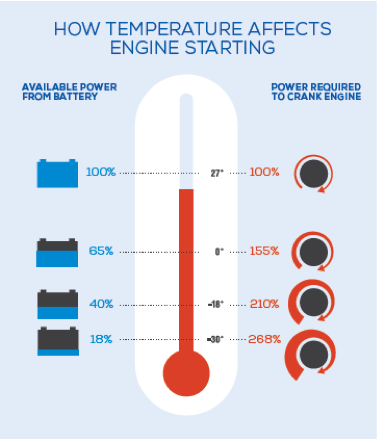Exide: Tips for a healthy battery this winter

Batteries lose a great deal of their cranking power in cold weather, which is the reason why battery failure most frequently occurs in winter. Poorly performing batteries often continue to loyally start the engine for months, only to fail the first time they’re exposed to a cold night on the roadside. Unexpected battery failures are expensive and inconvenient, but can be avoided with the right approach to battery maintenance. Exide Technologies offers tips on how to keep your battery in top condition throughout the winter months.
Covid-19 has changed driving behaviours. More people are working from home and using their car for fewer and shorter journeys for business and pleasure. This is great for the environment and reduces our fuel bill, but the increased likelihood of breakdowns remains a potential cost factor.
Batteries older than four years can particularly struggle, as ageing will have already reduced their capacity. They will thus be more likely to have issues cranking the engine in lower winter temperatures if only partially charged. Car batteries work best at a temperature of 27°C. By the time the temperature falls to 0°C, even a fully-charged battery has lost around a third of its starting power. Cold weather also means that more energy is required to crank the engine, creating a double effect of less available power and increased energy demand.
Electrical equipment such as alarms and keyless access systems consume energy even when the vehicle is not in use, draining the battery when the car is off the road.
Longer journeys are key
Short journeys may not be enough to keep your battery in a healthy state of charge. The alternator ideally needs at least 10 miles on the motorway to fully recharge the battery, so short trips to the supermarket may not suffice. In fact, shorter journeys are often bad for the battery as they may not offset the energy cost of starting the engine and powering on-board electrical equipment during the trip. To keep your battery in a healthy state of charge, make sure you go for longer drives regularly, or consider plugging in your car’s battery for a recharge.
When batteries enter a low state of charge their performance can be permanently impacted, increasing the chances of failure during winter.
Keep your battery charged
If you don’t have a reason to go on longer trips, a great alternative can be to use a charger. Exide Technologies recommends its Exide 12/7 or 12/15. These are designed to also work as a maintenance charger once the battery is recharged, which preserves its lifespan and keeps it in a proper state of charge. Exide advises recharging your battery at least every four to six weeks if your vehicle is off the road.
If you don’t have access to a charger, workshops can always help. They will typically test your battery using a professional tester and will have a recharger on hand in case it’s needed. If the voltage is lower than 12.5V, measured with key off at battery terminals, the battery must be recharged straight away
The right technology for the job
Exide Technologies says its Exide Premium Carbon Boost “easily handles” extreme weather. It recharges up to twice as fast a conventional battery and offers 30 per cent more starting power. Fast recharging means it reaches a healthy state of charge more quickly, reducing the risk of battery failure and vehicle breakdown.
It also singles out the Exide AGM and EFB batteries as offering “excellent performance in cold weather.” Designed in Exide’s original-equipment business for leading European carmakers, they provide exceptional electrical performance and were specially designed to support the start-stop powertrain. EFB batteries can also be used in conventional cars without start-stop powertrains for additional electrical performance. Of course, regardless of what battery technology you use, the right approach to maintenance will preserve battery lifespan.

• Recharge your battery every 4–6 weeks to keep it in optimum condition if your vehicle is off the road
• Do not let your battery voltage drop below 12.5V
• High-performance batteries offer reduced risk of breakdowns


 Pearse Walker; Pixabay
Pearse Walker; Pixabay
Comments